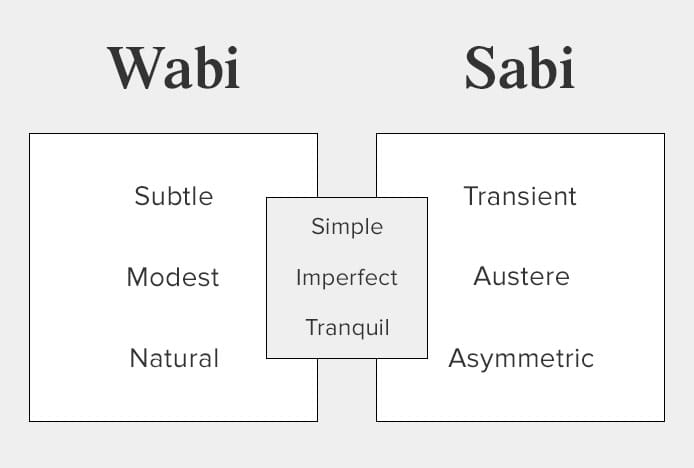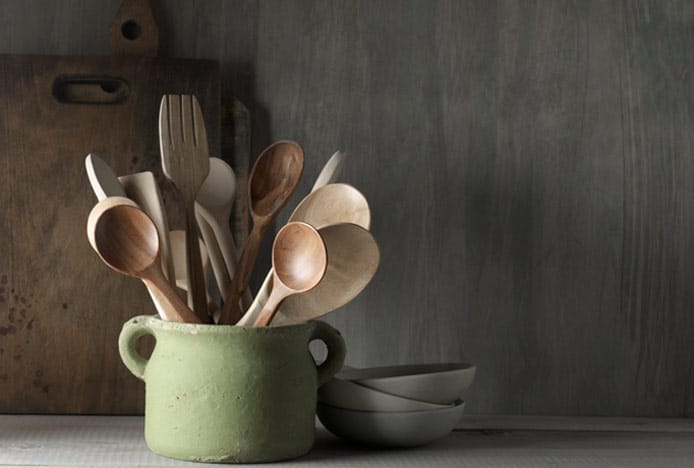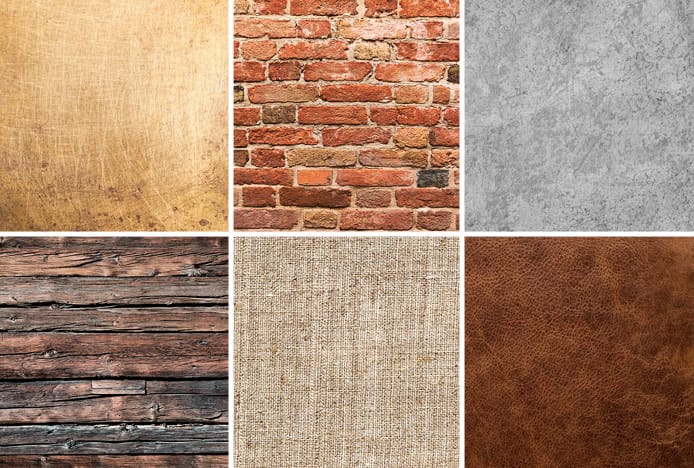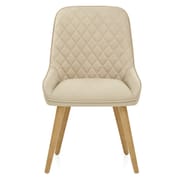Wabi-Sabi Design in Your Kitchen
By Sophie Hardy, 24th March, 2017
Don’t worry, this is not an article about Japanese horseradish. Wabi-sabi is actually an ancient Japanese philosophy that can be applied within interior design, and to your lifestyle as a whole. Our blog post aims to enlighten you with our understanding of the term and make some suggestions on how you can embrace it in your kitchen, focussing on the materials used, colour schemes, and furniture.

What Does Wabi-Sabi Mean?
The two words actually have separate meanings that have been reinvented many times. Today, wabi is described as simplicity, humbleness, and being in tune with nature, whilst sabi is the beauty of age and wear.
It originated centuries ago with the Japanese tea ceremony, which is a Zen Buddhist ritual for making and sharing a cup of tea, but wealthy masters turned it into a way of showing off with extravagant and expensive teahouses and utensils. As a backlash, the wabi-sabi way of tea was formed when one respected tea master deliberately chose to use simple and imperfect bowls and cups. Since then it has become the time-honoured and renowned way to have tea in Japan.
The term doesn’t have an exact English translation, but essentially wabi-sabi acknowledges and accepts the fact that everything is imperfect, incomplete, and temporary.

What Makes a Wabi-Sabi Kitchen?
You may already have a wabi-sabi approach to your décor and not even realise. That old kitchen rug you refuse to throw out because the frayed edges and faded fabric remind you of the story and history of your home - that is wabi-sabi.
It’s quite the opposite of typical contemporary design, with more of a casual and relaxed aesthetic with few clean modern lines. That’s not to say it’s an excuse for mess, dirt, or carelessness, especially not in the kitchen, but not everything has to look perfectly pristine. Think more along the lines of shabby-chic and industrial style interiors, which have been on trend in the past few years with their weathered and country aesthetic.
Take influence from nature, which is rarely perfect or symmetrical and will eventually decay, and replicate this concept in the kitchen. Choose to keep your old furnishings and watch them change and gain character with age, or buy simple handcrafted crockery and accessories and appreciate their subtle beauty.

Materials Used
The materials in a wabi-sabi kitchen should be rustic and natural. Opt for materials that will age well or have a natural patina already. For example, real leather will become worn and wrinkled with use, fabric will become threadbare, painted wood will begin to peel over time, metal will rust, and so on. These imperfections are to be admired rather than retouched or replaced.
Steer clear of modern polished surfaces like granite and laminate, instead opt for rustic wooden worktops, concrete floors, and exposed brick walls. These all have interesting textures and unique blemishes and details that will add originality and history to the room. Soften up these rough textures with an old linen rug and fabric stools and chairs, or bring in another contrasting texture with a sisal or bamboo rug. For appliances and kitchenware, metals with a natural tarnish like brass and copper will suit the style much more than spotless shining chrome or stainless steel.

Colour Scheme
Colours fade and become less vibrant with age, and so a muted colour scheme is naturally formed and preferred in a wabi-sabi setting. Due to the natural materials used, a typical colour scheme will include earthy browns, warm oranges, greys, and creams. You can of course incorporate it into your existing décor, as the subtle rustic style can also make a striking contrast in a modern setting if you can’t commit completely to the simple understated look.
Furniture Style
Handmade furniture is an essential element in a wabi-sabi interior, and although imperfections are welcome, it is not an excuse for mistakes or poor craftsmanship. It’s more about embracing traces of the making process and the history of the item - a distinctive knot in a wooden piece of furniture or paint drips on a handmade bowl for example.
An old leather chair with five years of wear and tear will have plenty of wabi-sabi character, so hold onto your old furniture for a simple way to get the careworn and aged look. Plus, it is better for the environment and easy on your bank balance too, which is in unison with Lagom, another lifestyle trend for this year. Recycled furniture or pieces with a salvaged look are also great for this, or maybe you have some antiques or family heirlooms that will lend a truly lived-in look.
If your current kitchen is ultra-modern and lacking furniture that is likely to age, or if you can’t source any authentic antiques to get the look instantly, you could get a head start with some of our handcrafted and vintage style designs. The Vice Industrial Stool (pictured below) is a great example, with its solid wooden seat and antiqued frame forming a rustic piece with understated beauty.
Take a look at some of our wabi-sabi style designs below:
So, wabi-sabi design is simpler than its name suggests! Once you learn to find the beauty in your weathered kitchen table and your tarnished brass taps, you’re half way there! Many of us take comfort in the familiarity and nostalgia of our cosy lived-in homes anyway, which just so happens to tie in nicely with last years popular Hygge trend.
Recommended Articles
Creating Symmetry & Balance in the Kitchen
Symmetrical kitchens are balanced, calming spaces. Top tips for achieving the look..
6 Ways to Use Texture in Your Kitchen
Six easy ways that you can use texture to liven up your kitchen design..
Creating A Kitchen With Good Feng Shui
For a welcoming and refreshing kitchen, you need to optimise the Feng Shui..
How To Create A Glamorous Kitchen
Discover how to turn your kitchen into a glamorous space full of luxury..
Recent Popular Posts
6 Ways to Use Texture in Your Kitchen
Six easy ways that you can use texture to liven up your kitchen design..
How to Brighten up a Dark Kitchen
Whether your kitchen's a small space, or just poorly lit, brighten it up in 5 steps..
3 Easy Steps to Scandinavian Style in Your Home
Featuring natural materials, clean lines and light spaces, Scandi style is clean and cosy..
How to Create a Cosy Corner in Your Home
Staying in is the new going out! Pop the kettle on and relax in a cosy corner..














 Vice
Vice Bloc
Bloc Oslo
Oslo